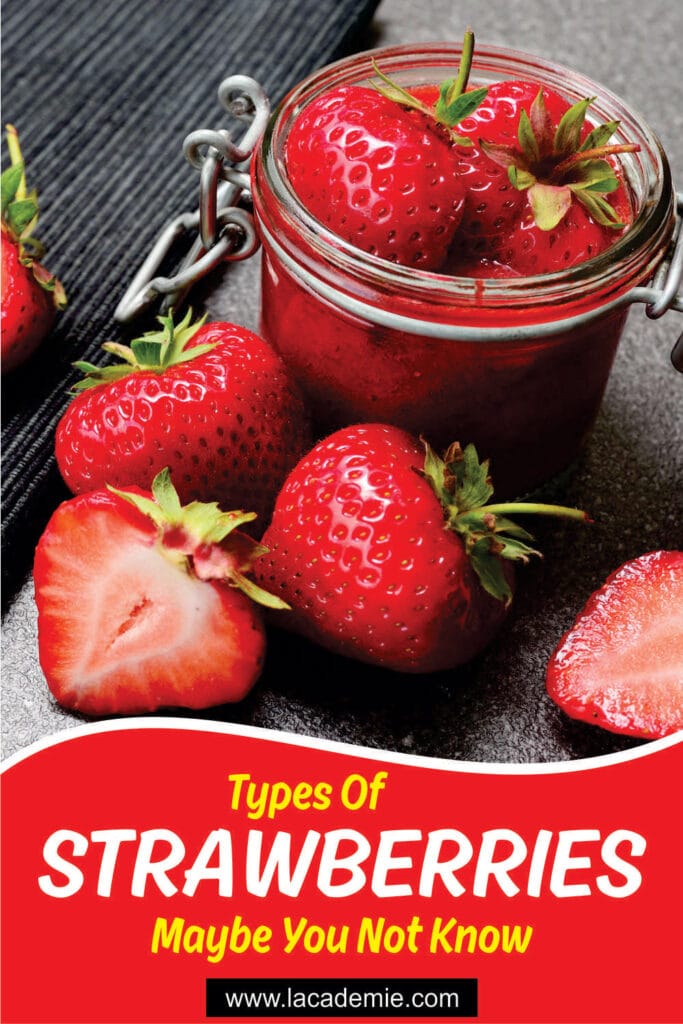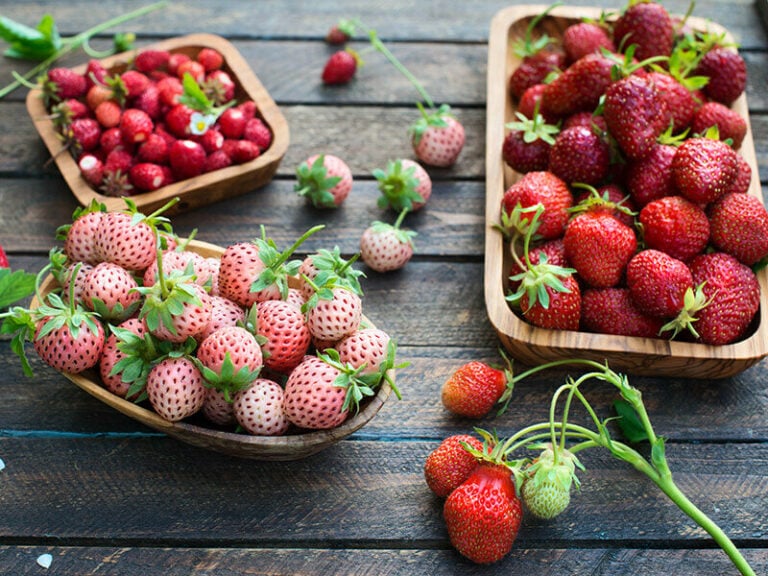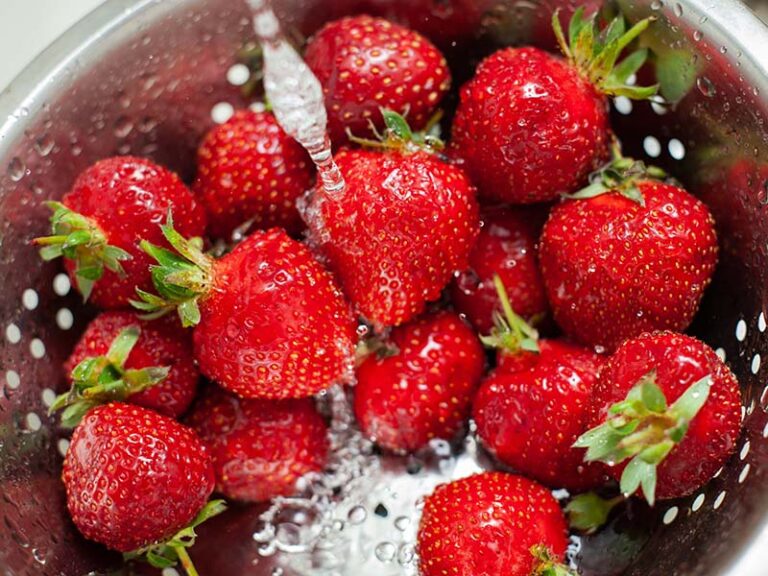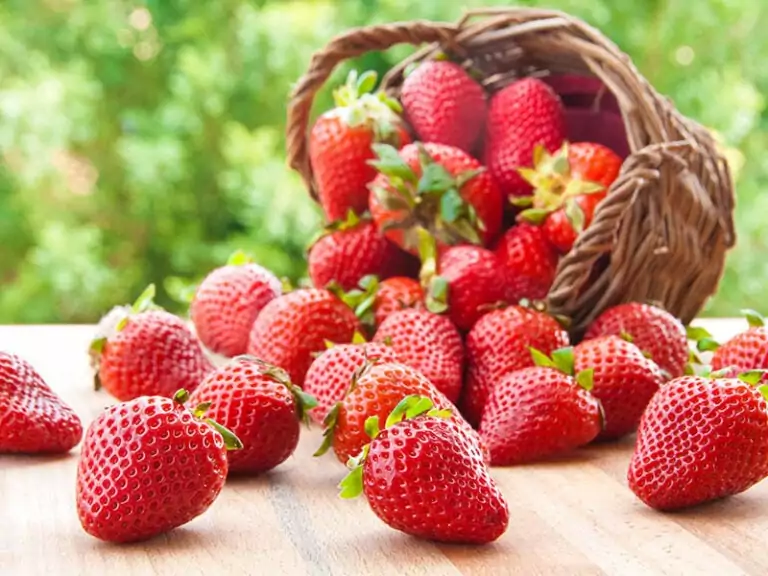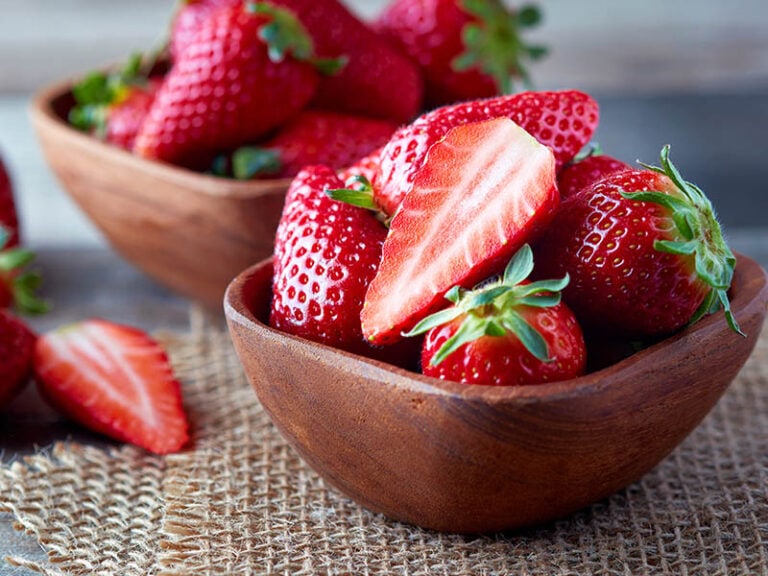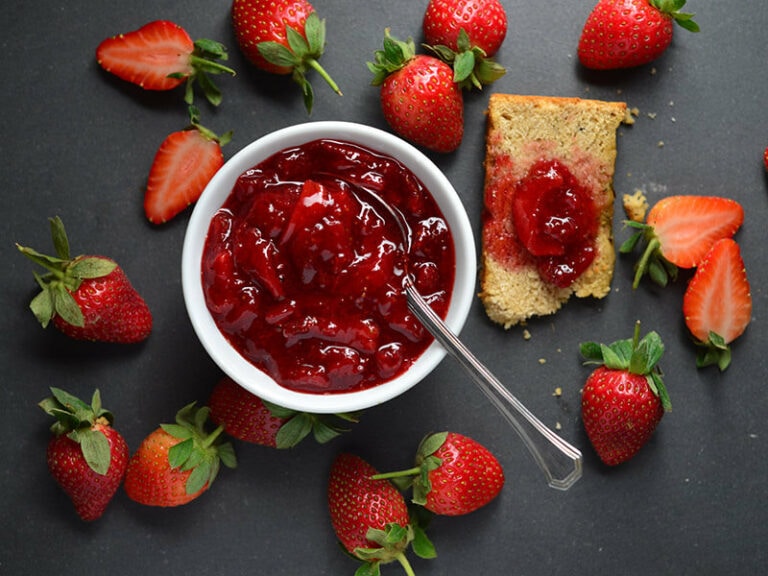There are dozens of types of strawberries worldwide, but most people only know a little portion. So if you are in the same boat as them, it is better to learn some from now on.
In this article, you will learn more than twenty-three types of strawberries. Not only do you know their names, but you will also learn about their taste, growing conditions, and the most suitable ways to store these strawberries.
That’s why after the reading, I am sure you will be able to pick some types for your garden renovation. So, when you are ready, jump in with me to explore more!
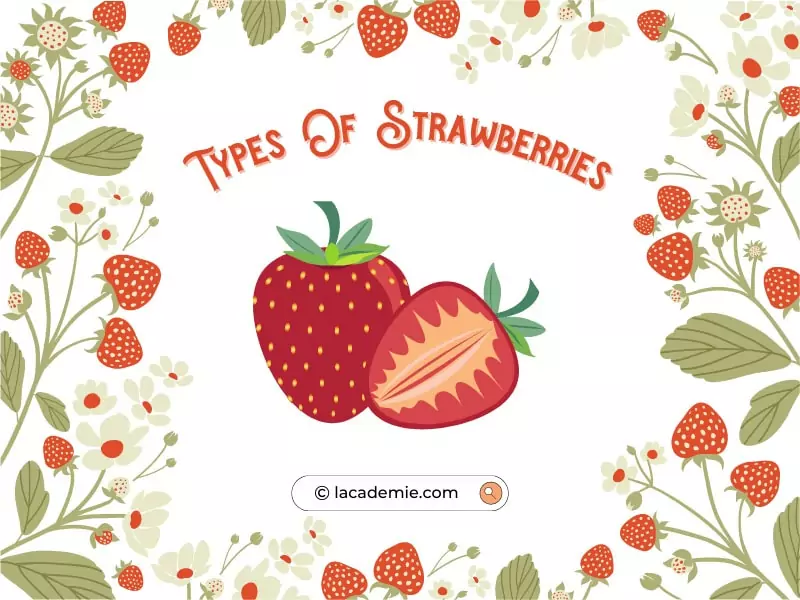
Strawberries And Their Main Varieties
Strawberries are one of the most well-known fruits in the world. It has a triangle shape with numerous yellow seeds on the surface. Indeed, although having “berry” in their name, strawberries are not real berries. Instead, they are false berries, combining many small individual fruits inside.
Botanically, strawberries belong to the Rosaceae (or rose) family. Many people also wonder about the differences between strawberries and raspberries – another famous fruit in the rose family.
Usually, you think there’s only one type of strawberry. But there are more. Strawberries have more than two dozen varieties worldwide. And people will divide the types according to the season because each condition in different seasons will produce varieties of fruits and flavors.
In general, there are three typical bearing times, including June-bearing, ever-bearing, and day-neutral. Gardeners also know useful ways to help strawberries ripen.
- June-bearing strawberries usually give a bountiful crop each growing season in June. The harvesting range is three weeks.
- Ever-bearing strawberries usually give fruits from two to three separated yields ranging from a big crop in spring to a light crop in summer and an extra crop in late summer fall.
- Day-neutral strawberries usually bear fruit throughout the growing season from early June to late August.
Although there is such a typical fixed period, the harvest season of strawberries will come earlier or later, depending on the air temperature and the length between day and night of your growing region.
Check out this planting strawberries guide for beginners!
Some Popular Types Of June-Bearing Strawberries
For easy tracking, I will introduce each in order of harvest seasons. And the beginning will be eleven popular June-bearing strawberries, which usually bear fruit at the start of spring to summer. Let me guide you into more details!
1. Earliglow
Earliglow strawberries have been officially grown in America since 1975. The delicious summer fruit earns its impressive name by its two distinct characteristics, ripening early in the season and having the most glow red color.
Earliglow is medium-size with firm and glossy skin. The fruit size will be in a decreasing trend with the season. However, many gardeners still choose this variety because of its ease of growing and resistance to pests, specifically Verticillium and Red Stele.
How To Grow
- Distance between plants: Eighteen to twenty-four inches.
- Soil: Well-drained and rich in organic matter. If not, you should look for organic fertilizer.
- Necessary conditions: Sun and moisture.
Because this plant likes sun and moisture, you should choose a suitable location for it and regularly check the soil moisture. Make sure the soil is overly dry. When you finish harvesting a crop, you just need to remove the older leaves and take care of the plants as usual.
How To Eat
With their sweetness, Earliglow strawberries are a fresh eating choice. Or, you can take advantage of its color to make jams. Besides, since its freezing ability is excellent, you can also store it in the freezer for future uses.
Season
Earliglow will bear fruits in early summer, specifically in June, from zone 4 to zone 8.
Taste
Earliglow has a sweet taste standing out in the strawberry world.
2. Camarosa
South California is the region that grows and contributes most of the Camarosa strawberries. Like Earliglow, Camarosa has an early harvest in the season with a bountiful yield. Besides, this variety also produces large, firm fruit with a deep red color and rich flavor.
How To Grow
- Distance between plants: When mature, this strawberry can grow from 6 to 12 inches in height and width. Thus, you need to leave the in-row distance at 14 inches accordingly.
In addition, Camarosa can also live well in containers. So if your garden is spaceless, you can grow one or two in a container. Make sure to have enough space for full sunshine to go through.
- Soil: Well-drained and rich in organic matter.
- Necessary conditions: Full sun and moisture.
In particular, you should continue watering after the plants have given flowers and fruits to ease care in the next harvest period. And if the weather turns cold, you should cover the plants with mulch to protect them for the upcoming season.
How To Eat
With its beautiful deep red color, you can treat Camarosa strawberries as a garnish for baked goods, such as cakes and ice cream. Besides, you can also make some sweets like jams or puree to utilize the variety of sweetness.
Season
Depending on your region’s conditions, Camarosa will give fruit between February and June in zone 5 to zone 8.
Taste
Camarosa has a firm and juicy texture. When you taste this type of strawberries, you will feel a balanced flavor between sweetness and acidity.
3. Allstar
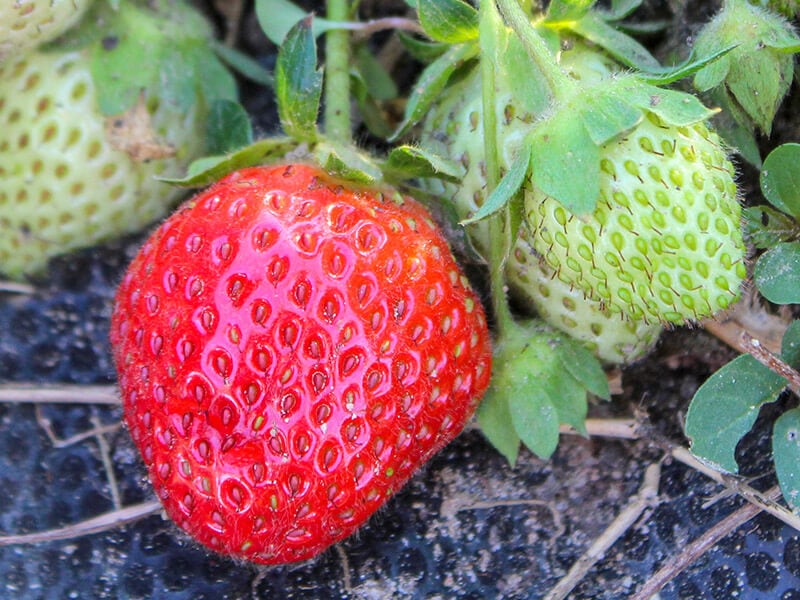
As its name suggests, Allstar is the star in the strawberry harvest varieties. It produces “monster” crops with many large, red fruits. The Allstar strawberries are orange-red and have a firm and juicy texture, giving you an instant refreshment when eating them.
However, their tender skin makes this strawberry more fragile to transport than others, so it is not usually grown commercially but is mainly popular among the home-grown community.
How To Grow
- Distance between plants: Each plant should be placed six to eighteen inches apart.
- Soil: Well-drained and rich in organic matter.
- Necessary conditions: Full sun and moisture.
Specifically, you can apply organic nutrients and evenly till the soil surface before planting. In the frost season, you should spread a thin layer of straw on the surface to keep the plants warm.
Besides, biological agents such as snails and birds can physically attack Allstar. Thus, you can use plastic nets or other non-harmful drugs and traps if needed.
How To Eat
Since Allstar has a large size and rich texture, it is very suitable for baking and roasting. Besides, as this variety can keep fresh for several weeks after harvesting, you can also freeze it for future uses.
Season
The harvest season of Allstar usually lasts for two seasons, one in late spring and another starting in early summer from zone 5 to zone 9.
Taste
Unlike Earliglow, Allstar has a sweet yet mild flavor, making it very pleasant to eat fresh.
Let’s experience planting Allstar strawberries in an outdoor container!
4. Cavendish
Native to Nova Scotia, Cavendish is a hybrid crossing between two varieties having winter tolerant and large fruit. Thus, its fruit is big-sized and firm with a beautiful heart-shaped form, creating its popularity in the strawberry trade.
Moreover, during winter, the tree usually dies at the top and regrows from the base in the spring. Therefore, you need to pay attention not to damage the roots in the winter to ensure the next crop.
How To Grow
- Distance between plants: When mature, this strawberry can grow to 8 inches in height and 24 inches in width. Thus, you need to set the distance between them accordingly.
If you don’t have a lot of garden space, you can also grow Cavendish in a suitable pot or container. They will grow well outdoors in summer with regular watering. However, if winter comes, you may want to bring them indoors.
- Soil: Well-drained and rich in organic matter.
- Necessary conditions: Full to partial sunlight and average moisture.
Noticeably, Cavendish is moderately moisture-loving and will not tolerate standing water. Besides, this strawberry variety grows well in alkaline soil, so you can use compounds such as lime powder and eggshell to fertilize the soil.
How To Eat
Thanks to their sweetness and firm texture, you can eat Cavendish raw or use them for baking cakes. In addition, making strawberry preserves from this type of strawberries is also a perfect choice.
Season
Cavendish strawberries will bear fruit throughout late spring to early summer. They are mainly grown in zone 3 to zone 7.
Taste
When you eat Cavendish strawberries, you will taste an excellent sweetness that makes you want to eat more.
5. Honeoye
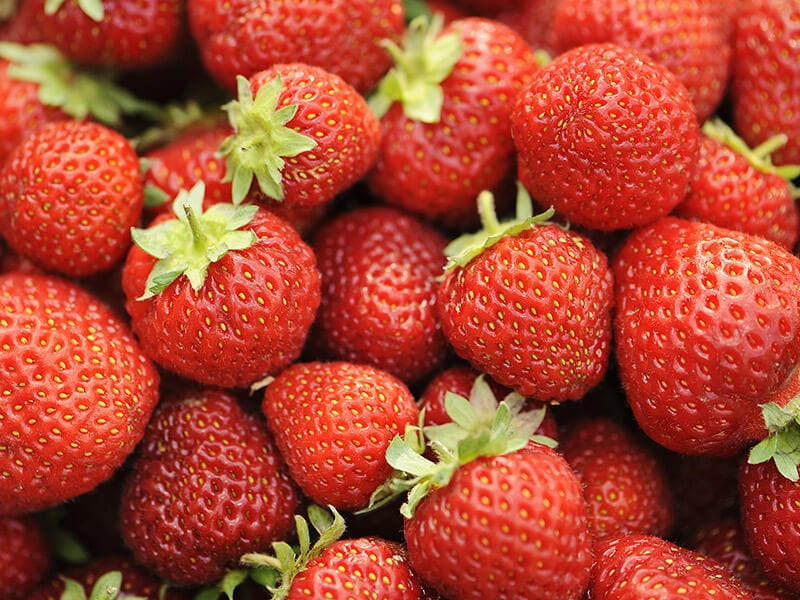
Honeoye strawberries were developed by Cornell’s New York State Agricultural Experiment Station in 1979. And they have been a big hit in the strawberry family, thanks to their winter hardiness and high yield.
The fruit of Honeoye is large, firm, and red, with a consistent size of fruit throughout the harvest season. Besides, it can also tolerate lower temperatures compared to other varieties. Therefore, many gardeners in the U.S choose to buy it for long-term planting.
How To Grow
- Distance between plants: From twelve to eighteen inches apart.
- Soil: Well-drained and rich in organic matter.
- Necessary conditions: Full sunlight and moisture.
In particular, you will get the best taste of Honeoye by planting them in raised beds or lighter soils. Besides, weeds are also a big problem in planting Honeoye. Thus, you should better clean up the soil and beds before starting the season.
How To Eat
To enjoy the natural taste of Honeoye, you can pick and eat fresh fruit in the garden. Or, you can best use them for making jams, pies, and baked goods.
Season
Honeoye bears fruit in Summer, usually from June to early July. And they are best grown in zone 3 to zone 8.
Taste
By biting the fruit, you will feel its firm and watery texture with a sweetness exploding in your mouth.
Want to know more about Honeoye? Learn more here!
6. Jewel
Jewel originated in the New York State Agricultural Experiment Station in 1985. Until now, it is one of the preferred types of strawberries to grow. Not only grown in hot regions, but Jewel strawberries can also survive in cold places.
In addition, this fruit also requires less care than others. For one year of planting, you will receive wedge-shaped and deep red fruits from Jewel plants with incredible tastes. Now, do you understand why Jewel is preferable?
How To Grow
- Distance between plants: Plant twelve inches apart between plants.
- Soil: Well-drained and rich in organic matter.
- Necessary conditions: Full sunlight and moisture.
Although easy to grow in any soil, Jewel will grow best in soil with a moderate pH, between 6 and 7. Therefore, you can test the pH to make the best soil for your plants. Also, you should pay attention to weeds and pests, like snails, while taking care of plants.
How To Eat
Like other strawberries, you can eat Jewel raw or make plenty of dishes from them, such as cakes and jams. In addition, with good low-temperature preservation, you can store them in the freezer for future use.
Season
Jewel is suitable to cultivate in zone 4 to zone 8 and will bear fruit in summer, specifically in the middle of June to early July.
Taste
Jewel tastes mild and sweet with a hint of aromatic flavor.
7. Cabot
Cabot is a widely grown variety of strawberries in North America. That’s because Cabot has winter hardiness and disease resistance. Compared to other glossy strawberries, Cabot has an ugly appearance.
The fruit has a rough skin, sometimes even split on the surface. However, the fruit’s color and taste are all loved by the eaters, respectively attractive red and tasty.
How To Grow
- Distance between plants: From twelve to eighteen inches between plants.
- Soil: Well-drained and rich in organic matter.
- Necessary conditions: Full sunlight and moisture.
In particular, Cabot will grow well in soil having pH levels from 6.5 to 6.8, slightly acidic. Therefore, you can take advantage of all ways to achieve the perfect pH level. For example, apply a fertilizer high in ammonia or sulfur to the soil a year before planting begins.
How To Eat
You can eat Cabot fresh or best used in desserts, smoothies, and syrup. Or, you can treat it like a garnish for sweet dishes.
Season
After one year of planting, you can harvest fruit from the middle of June to early July. The best place to grow them is from zone 4 to zone 8.
Taste
Cabot has a delicious eating experience with a firm texture and sweet taste.
8. Chandler
Chandler is the most typical option to grow by gardeners in California and the Eastern U.S. The plant will bear extra-large fruit with glossy red color. Inside, the flesh is red and juicy without any white center, which causes dryness in strawberries. Thus, you will love this fruit at first taste.
How To Grow
- Distance between plants: From twelve to twenty-four inches apart.
- Soil: Well-drained and rich in organic matter.
- Necessary conditions: Full sunlight and moisture.
Attentionally, Chandler is susceptible to root rot and less resistant to pests and diseases. Therefore, you should pay close attention to the drainage after irrigation and prepare plans to prevent seasonal diseases for the best harvest season.
How To Eat
You can enjoy Chandler fresh or use them to make preserves and pies.
Season
Chandler usually bears fruit in spring and early summer.
Taste
Chandler is a sweet and juicy fruit. When you eat a piece of strawberry, you will feel the sweet water flowing out from the hard texture with a fragrant aftertaste.
Step by step growing Chandler strawberries in your home.
9. Sparkle
Sparkle has great adaptability to cool climates. In particular, the strawberry yields medium-sized fruit with an attractive deep red color. The flavor is also an advantage of this type, making it the favorite berries of Northern people.
To have a good crop, many gardeners advise that you should plant Sparkle in a moderate thick bed instead of a thick bed. This technique will help you keep the right amount of water and not rot the roots of the plants.
How To Grow
- Distance between plants: From eighteen to twenty-four inches apart.
- Soil: Well-drained and rich in organic matter.
- Necessary conditions: Full sunlight and moisture.
Like Chandler, Sparkle is weak in fighting pests and seasonal diseases, such as gray mold, fruit rots, and scorch. Thus, you should prepare to prevent seasonal diseases from the beginning and plan in advance measures to cure them.
How To Eat
You can eat it raw after harvesting to enjoy the best flavor. Or, you can use it to make the tastiest jams and pie fillings.
Season
Like most June-bearing strawberries, you will be able to eat Sparkle in summer, specifically in June. And it will taste better when you plant from zone 3 to zone 8.
Taste
Sparkle is flavorful and extremely sweet. That’s why it will effortlessly become your favorite if you are sweet.
10. Northeaster
Northeaster is a June-bearing strawberry variety developed by USDA in 1996. As its name says, Northeastern is most suitable to grow in the Northeastern United States.
Like other June-bearing varieties, this strawberry yields a very extensive crop with large-sized berries. In addition, Northeast also has lots of runners. Therefore, you need to orient it to crawl out and stick to the ground as you plan instead of letting it grow out of control.
How To Grow
- Distance between plants: From twelve to eighteen inches.
- Soil: Well-drained and rich in organic matter.
- Necessary conditions: Full to partial sunlight and moisture.
In particular, for the crop in the following years to be highly productive, you should cut off the first flowers to focus nutrition on rooting and healthy plants. Besides, before each spring crop, you need to fertilize the soil moderately to increase the nutrients for the plant.
How To Eat
Gaining a pleasant flavor, you can eat it raw, make a cake, or process it into jams and jellies.
Season
Northeast’s harvesting season usually occurs in the late spring to early summer and the harvest period is short, usually only three to four weeks. The growing zone of this strawberry variety is from zone 4 to zone 8.
Taste
When eating this June-bearing strawberry, you will taste the juiciness and sweetness in its flesh.
11. Tillamook
Native to Oregon, Tillamook was first introduced in 2004. Lately, it has become a popular strawberry variety in the processed food industry due to its tremendous fruit-yielding ability.
Besides, Tillamook also produces enormous berries and maintains that size throughout the harvest seasons of the year. Thus, for growers and producers alike, Tillamook is very efficient at harvesting and processing.
How To Grow
- Distance between plants: From ten to eighteen inches between plants.
- Soil: Well-drained and rich in organic matter.
- Necessary conditions: Full sun and moisture.
Because this is a sun-loving plant, you should apply a layer of straw to protect the plant in the frost season. In addition, you should cut off the first flowers so that the plant can concentrate nutrients for powerful roots, creating conditions for a bountiful season in spring.
How To Eat
You can eat Tillamook raw or feel pleased to put them in many dishes. Among them, the most delicious one is using Tillamook to make ice cream, Oregon’s famous food.
Season
The Tillamook berries will be ready in early summer, specifically in the first half of June.
Taste
Tillamook tastes excellent sweet with a hint of berry flavor.
What makes Tillamook ice cream special? Check it out!
Ever-Bearing Strawberries For Your Delicate Smoothie Bowl
You have gone through spring and the middle of summer. Now let’s get ready to travel from summer to fall. Next, I will give you information about the six yummiest strawberries in the ever-bearing season. Let’s dive in deeper!
12. Quinault
Bred by researchers at Washington State University, Quinault earns its name after a local area of this state, the Quinault community. The fruit has a heart-shaped form and deep red color with a large size, up to two inches in diameter.
In addition, you will fall in love with its soft and juicy texture, considered pleasantly tasty. However, compared to other strawberries, the fruit is so soft that people do not grow it for commerce but for home cooking.
How To Grow
- Distance between plants: From eighteen to twenty-four inches apart.
- Soil: Well-drained and rich in organic matter.
- Necessary conditions: Full sun and moisture.
To get both crops, you should start planting plants in early spring. Like other strawberry varieties, water and nutrients are two things you need to keep in mind. Especially in the hot summer, you should water regularly and remove dry leaves for the best crop in the fall season.
How To Eat
You can use Quinault for desserts and preserves or eat them fresh. However, you should not freeze them in the freezer because of their soft flesh.
Season
Quinault will bear fruit from late spring to mid-autumn, mainly yielding in late June and August. You can find this strawberry growing in zones 4 to 8.
Taste
Quinault has a soft and juicy fruit, with prominent sweetness making your mouth keep watering due to its berry flavor.
Explore how to renew your Quinault beds by thinning plants!
13. Ogallala
Ogallala is a strawberry variety researched by USDA and the University of Nebraska in 1956. This fruit is suitable for growing in places where soil conditions are not too good, thanks to its drought and disease tolerance.
Ogallala produces large-size fruits with a firm and juicy texture. Besides a beautiful dark red color, the fruit has a tasty heaven flavor.
How To Grow
- Distance between plants: From eight to ten inches between plants.
- Soil: Well-drained and rich in organic matter.
- Necessary conditions: Full sun and moisture.
In the first year of growing Ogallala, you will have to put in a lot of work because this is the period when the plants are weakest. You need to pay attention to the amount of water and fertilizer in the soil in the first year.
In particular, avoid applying too much fertilizer because it will cause diseases. You should also remove some flowers in the first season to save nutrients for the roots. After a year, your plants will be stronger and more resistant to drought and many diseases.
How To Eat
To enjoy Ogallala, you can eat them raw or utilize them as an ingredient in cooking and baking.
Season
You will collect the fruit of Ogallala in two main crops, once in spring and once in fall, but specifically, the main crop will start from June to August. You can find Ogallala in the area from zone 3 to zone 8.
Taste
By eating a corner of Ogallala, you will taste sweetness with a hint of wild strawberry flavor.
14. Fort Laramie
Developed by USDA in 1973, Fort Laramie is a popular ever-bearing berry in America, especially for Northern gardeners since they can withstand winter’s devastating cold well.
This type produces huge crops of bright red berries with a charming aroma. Inside, the flesh is juicy and varies from dark pink to red.
How To Grow
- Distance between plants: From eighteen to twenty-four inches.
- Soil: Well-drained and rich in organic matter.
- Necessary conditions: Full sunlight and moisture.
Notably, this plant prefers sandy loam rich in organic matter. Therefore, if you do not have this type of soil, you can buy sandy soil mixed with sawdust to put in pots to plant them. It will have the same result as growing in a garden.
How To Eat
With its authentic taste, you can use Fort Laramie to make jams, preserves, jellies, or any desserts needed sweet.
Season
Fort Laramie will yield fruit twice a year, including the first crop in spring and the second in late summer or fall. Meanwhile, the Fort Laramie planting zone is from zone 3 to 7.
Taste
Fort Laramie tastes sweet and aromatic with a honey-like afternote.
15. Ozark Beauty
Ozark Beauty is an ever-bearing berry developed in Arkansas. It is among the most adaptable strawberry cultivars with a planting area expanding from zone 3 to zone 9. When mature, Ozark Beauty will bear medium-sized and deep red berries with vigorous productivity.
How To Grow
- Distance between plants: From six to eighteen inches apart.
- Soil: Well-drained and rich in organic matter.
- Necessary conditions: Full sun and moisture.
Although this variety is cold-tolerant, its flowers are less tolerant. Therefore, you should spread a thin layer of straw on the surface to protect them. Besides, the straw cover will also help to keep the plants moist. In a hot region like zone 8, you should give it some shade in the afternoon.
How To Eat
Thanks to its flavor, Ozark Beauty is a perfect ingredient for making jams and desserts.
Season
As an ever-bearing strawberry, Ozark Beauty has two harvest crops in late spring, early summer, and fall.
Taste
Like Fort Laramie, Ozark Beauty has a sweet and honey-like flavor with a fragrant note.
Do you know how to transplant Ozark Beauty into bigger pots? Jump in!
16. Everest
Everest has a unique characteristic among other strawberries. It is a climbing strawberry that you should plant next to a fence or anything with a rigid structure for the plant to grow. Under ideal conditions, Everest strawberries have fast growth and long life, about ten years.
How To Grow
- Soil: Well-drained and rich in organic matter.
- Necessary conditions: Full to partial sun and average moisture.
For this climbing plant, you need to pay attention to avoiding standing water because it will easily rot the roots and kill the whole plant. In addition, with the texture of the vines, you can grow it in a pot or basket and leave it where it can hang down is also a reasonable way to grow.
How To Eat
There are plenty of ways to eat Everest. You can eat them fresh or cut them into slices and treat them as garnishes to decorate baked cakes and desserts.
Season
Everest will yield fruit in late spring to early fall but specifically have a high yield from June to September.
Taste
With a medium size, Everest will be just enough to fit in your mouth. When you eat them, you will feel their juicy and sweet taste.
17. Albion
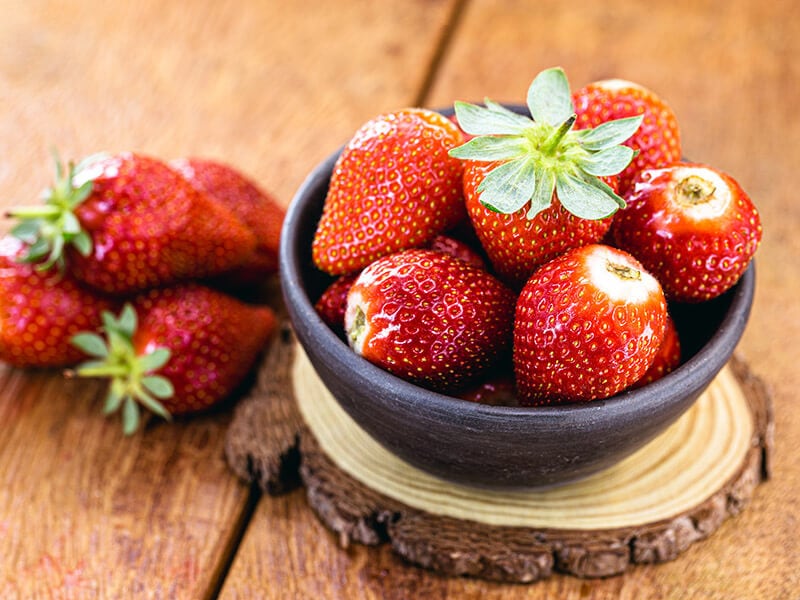
Developed by the University of California, Albion was an officially public variety in 2006. Albion is famous for its large and brilliant appearance. This strawberry has a firm texture and conical shape with the red outer skin.
In addition, it also gives high yield and good disease prevention. Specifically, a few diseases it is resistant to are verticillium wilt and Phytophthora crown rot.
How To Grow
- Distance between plants: Twelve to eighteen inches apart.
- Soil: Well-drained and rich in organic matter.
- Necessary conditions: Full sunlight and moisture.
Since Albion is extremely water-loving, you should actively check and water regularly to keep the plant healthy. Also, with continuous fruit yield, you should ensure your plants are full-picked to make room for other berries to grow.
Compared to other strawberries, Albion has higher heat tolerance. While others will die under summer temperatures, Albion will survive and continuously yield fruit well.
How To Eat
With soft texture and delicious flavor, you should eat Albion fresh or use it to make preserves and pies. Besides, freezing it is also a way to preserve it longer in your kitchen.
Season
Albion harvest season starts in June and throughout October. Meanwhile, the suitable planting area is from zone 4 to zone 7.
Taste
Due to its high sugar content, Albion strawberry is outstandingly sweet with a fragrant undertone.
Discover how different Albion and Seascape strawberries are!
Delightsome Day-Neutral Strawberries You Can Deny
Here comes good news for you! Unlike other types of strawberries, day-neutral strawberries have a longer harvest time in summer and fall, making sure you enjoy strawberries non-stop. What are they? Let’s find out now!
18. Tristar
Tristar is a day-neutral strawberry introduced in Maryland in 1981. Tristar produces firm and glossy berries in various sizes, from small to medium. The favorite feature of this plant is its ease of care, thanks to its disease resistance.
Not only do people plant Tristar for fruit, but they also use them to decorate or give gifts. The strawberry has an attractive white flower, knurled leaves, and red berries. All make up their shimmering appearance.
How To Grow
- Distance between plants: From eighteen to twenty-four inches between plants.
- Soil: Well-drained and rich in organic matter.
- Necessary conditions: Full sun and average moisture.
To ensure the most productive crop in the fall, you should cut off Tristar runners and flowers so that it concentrates nutrients on healthy roots and leaves for the upcoming season. Besides, you should spread mulch on the surface to keep it moist and prevent weeds from growing.
How To Eat
Besides eating fresh, you can use Tristar to make jams or freeze them for future purposes since they do not get rubbery after defrosting.
Season
As a day-neutral strawberry, Tristar will yield fruit from early spring to fall with plant zones ranging from zone 5 to 8.
Taste
Tristar has a firm texture and sweet taste that you would look for in a strawberry.
Let’s witness the fruiting ability of Tristar with your own eyes!
19. Seascape
Seascape is an easy-to-care strawberry variety. This strawberry will bear large-sized and firm berries with brilliant red color on both outer skin and inside flesh.
Also, Seascape is a productive strawberry, giving fruit throughout the season. Therefore, people are interested in growing this variety for the summer and autumn seasons, especially in North America.
How To Grow
- Distance between plants: From eight to twelve inches apart.
- Soil: Well-drained and rich in organic matter.
- Necessary conditions: Full sun and moisture.
As with other varieties, you should spread straw on the surface in winter to keep the plant warm while stretching it to the sides to let your strawberries have room to grow.
Besides, you should actively pick fruit to encourage your plants to bear more fruit and water them more often to keep the moisture if you grow plants in pots.
How To Eat
Because of its sweet taste, you can eat Seascape raw or use it to make desserts and preserves.
Season
Seascape strawberries season falls in spring, summer and fall, usually harvesting profusely in zone 4 to zone 8.
Taste
When eating a piece of Seascape, you will feel like you are eating honey because of its sweetness. In addition, it also leaves a berry aftertaste in your mouth after eating.
20. Delizz
Developed in Holland, Delizz is an F1 hybrid strawberry. Unlike other varieties, you can use their seeds to grow another plant. In addition, as a day-neutral variety, Delizz can bear fruit throughout the season, which varies from small to medium, with a conical shape and pretty red color.
Moreover, the plant grows orderly, and the combined colors between the leaves, flowers, and fruits are beautiful. All will contribute to the lovely appearance of your garden if you have some in your backyard.
How To Grow
- Distance between plants: About twenty inches between plants.
- Soil: Well-drained and rich in organic matter.
- Necessary conditions: Full sun and moisture.
When growing Delizz, the most important thing to keep in mind is the sun. Although they can be grown indoors and outdoors, in pots or on the ground, you need to ensure they get enough sunlight at all times.
How To Eat
Packing with delicious flavor, Delizz is perfect for making jams and desserts. Or, you can enjoy it fresh as a light snack.
Season
Since day-length does not affect Delizz growth, its harvest season starts from June and until fall frost, with a hardy area in zone 3.
Taste
Delizz has a sweet taste with a pleasantly aromatic aftertaste, making it preferable to young and old alike.
21. Camino Real
Compared to Camarosa, Camino Real has a lesser quantity of bearing fruit. But in turn, the plant produces large fruit with red wine color, which attracts more buyers’ tastes. Therefore, Camino Real is preferable in the fresh market and processing.
This strawberry cultivar is resistant to Phytophthora crown rot, Verticillium wilt, and quite resilient against Anthracnose. With proper cultivating technique, your tree can also fight agaisnt two-spotted spidermite.
However, Camino Real is quite susceptible to some common diseases such as leaf spots and powdery mildew. Hence, you need to pay a little attention to these diseases when taking care of this plant.
How To Grow
- Distance between plants: From twelve to eighteen inches.
- Soil: Well-drained and rich in organic matter.
- Necessary conditions: Full to partial sun and moisture.
Although Camino Real grows well in the shade, it will produce the best quality berries under enough sun. Therefore, you should pay attention to sun exposure, at least six hours of full sun daily.
How To Eat
Camino Real is delicious to eat after harvesting, or you can cook it for other purposes. Besides, this strawberry also tastes good after freezing. So, all your choice!
Season
The Camino Real harvest season only lasts for a few weeks in Summer with perennial crops mainly from zone 5 to zone 8.
Taste
Camino Real tastes playful with the juiciness and sweetness blending in your mouth.
Other Attractive Native Strawberries That Will Surprise You
Hold on, mate! You have got a little more to learn. In this final list, you will acknowledge some more types of strawberries worldwide. Stay tuned and keep reading!
22. Alpine Strawberry
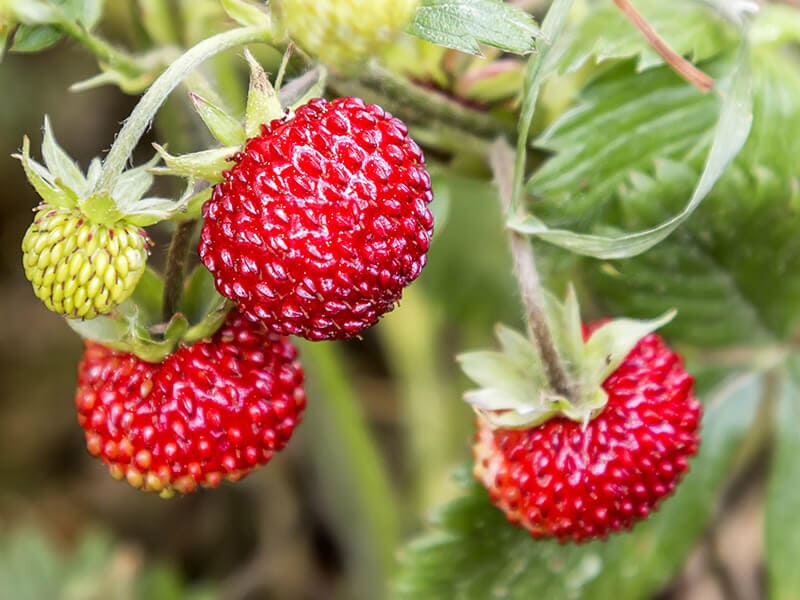
People first discovered Alpine strawberries in the low Alps 300 years ago. Unlike other strawberries, the old and wild Alpine has a tiny size, approximately half an inch in diameter. But instead of being small, it is loaded with enchanting flavor.
Besides, Alpine does not climb high, only about a foot high. And it looks prettier than other modern garden strawberries with its tiny white flowers and unique fruit above the leaves. Therefore, having an Alpine plant will highlight your garden with a cute corner.
How To Grow
- Distance between plants: From twelve to eighteen inches.
- Soil: Well-drained and rich in organic matter.
- Necessary conditions: Full to partial sun and medium moisture.
Since Alpine needs four to six hours of sunshine a day, you should plant your strawberries in a sunny location. However, its shallow roots are vulnerable to the hot summer sun. Hence, you should also equip a layer of straw covering to ensure that it does not affect the roots.
How To Eat
To its tiny size, you can use Alpine as a dessert topping or put in salad as a cherry tomato substitute. Also, enjoying Alpine fresh is a perfect choice to taste natural berry flavor.
Season
Compared to wood strawberries, Alpine has a longer cultivar, lasting from spring throughout summer to fall. It will grow best in zone 5 to zone 9.
Taste
Alpine has a bold and sweet taste with a wild berry undertone.
How to plant Alpine from seeds to fruits? Join here!
23. Virginia Strawberry
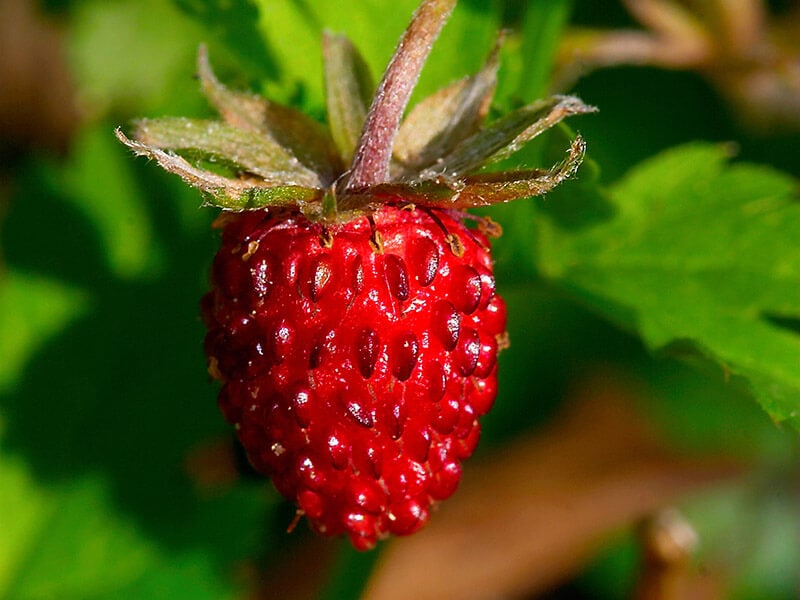
Virginia strawberry is a native wild strawberry belonging to the rose family (Rosaceae). It is rare in commercial nurseries but grows widely throughout the United States and Canada. You can recognize it by the shape of the fruit.
Virginia strawberries are tiny and have a red color. On the surface, the fruit has a seed-like embedded texture with sepals pointing backward, which looks like the texture of waffles if you look at it at a glance.
How To Grow
- Distance between plants: From twelve to fourteen inches between plants.
- Soil: Well-drained and rich in organic matter.
- Necessary conditions: Full to partial sun and medium moisture.
Virginia needs less moisture and more sun than other berries. So, you should pay attention to the sunlight they are exposed to, at least four to six hours a day. Besides, you still need to ensure enough moisture for plants, especially during the drought season, by using mulch.
How To Eat
You can eat Virginia fresh or enjoy it in a salad bowl and yogurt.
Season
Usually, Virginia will have blooms in May and bear fruit in June. You can find these everywhere in the U.S but mostly grow in zone 3 to zone 10.
Taste
Compared to other wild strawberries, Virginia is the sweetest strawberry.
If you do not know what Virginia wild strawberries look like, the answer is here!
24. Beach Strawberry
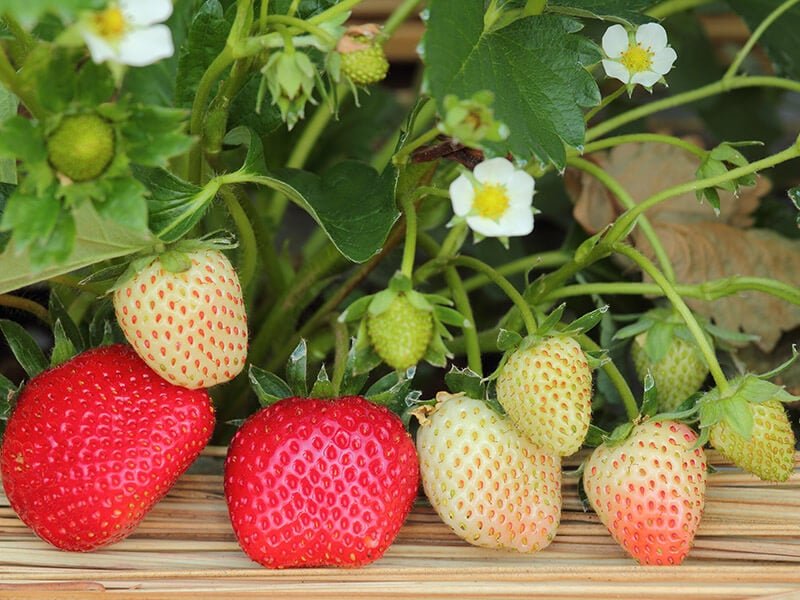
Beach strawberry is from a similar family to the Virginia strawberry, the rose family. People utilized this species for hybridizing the modern garden strawberry. The plant bears notably large fruit with red outer skin and white inside flesh, creating its unique look.
In addition, the Beach strawberry is drought tolerant and adhesive to the ground. Therefore, it is an incredible erosion-resistant plant, suitable for growing on the coast. In particular, Beach strawberry grows naturally on the Northern and Southern Pacific Ocean coasts of America and Hawaii.
How To Grow
- Distance between plants: From twelve to eighteen inches.
- Soil: Well-drained and rich in organic matter.
- Necessary conditions: Full sun and moisture to dry.
In early spring, you should prune and fertilize the plant to keep it healthy and ready for the new season. In addition, this is a low-moisture-tolerant strawberry, so you should also pay close attention to the ventilation of the soil, avoiding water retention.
How To Eat
Like other wild strawberries, you can eat Beach as a dessert fruit or use it to make desserts and sweets.
Season
Beach strawberries will bear fruit in late summer after blooming from mid-spring to early summer. For good growth, beach strawberries should plant in zone 4 to zone 9.
Taste
Beach strawberries taste rich and aromatic with the characteristic flavor of wild berries.
25. Elsanta
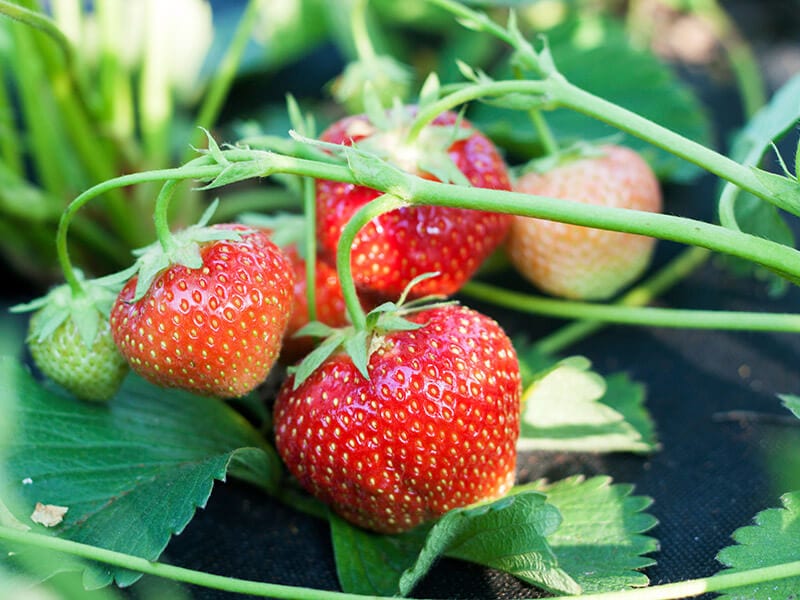
Plant Research International B.V. developed Elsanta in 1975. And the public has welcomed it immediately, especially the supermarkets. The reason is that Elsanta has a strong shell, so it is less vulnerable to damage than other strawberry varieties, leading to longer shelf life.
Besides, this Dutch variety of strawberries also has strong disease resistance and heavy yield. Therefore, its popularity is across the United States and Europe. When matured, Elsanta will have deep green foliage and large flowers with large-sized shiny berries ripening mid-summer.
How To Grow
- Distance between plants: Eighteen inches apart.
- Soil: Well-drained and rich in organic matter.
- Necessary conditions: Full sunlight and moisture.
Elsanta is easy to grow but also requires a lot of care to ensure the quality of the fruit. In particular, you should fertilize the plant right after the first harvest season to nourish the plant. Moreover, be aware of pests such as snails and weeds.
How To Eat
Elsanta is better consumed raw due to its fresh and delightsome flavor. But, if you want to cook them, you can make jams, jellies, or any dessert recipe that calls for strawberries.
Season
Elsanta will bear heavy fruit in the summer, specifically from mid-June to mid-July, with diverse growing areas from zone 3 to zone 10.
Taste
This strawberry does not smell too sweet, but its aroma is amazingly raspberry-like, making everyone fall in love. However, there are some complaints about the pale taste of Elsanta and other strawberries in the supermarket.
According to the theoretical explanation, strawberries lose their flavor when overwatered to promote growth. Hence, you can grow them yourself at home to avoid disappointment.
Many Types Of Strawberries Waiting For You To Discover
Nailed it! At this point, I know you have fully equipped yourself with knowledge about strawberries. Now, it is time for you to pick out one or two and proceed to renew your garden with them. So, which type of strawberries do you choose? Please comment below to let me know.
Or, if you have any questions about planting techniques, comment as well. I will try my best to help you out! The important thing is don’t forget to press the like button to support me and share this post with your friends to invite them to this strawberry community. It will be lots of fun!
Finally, I wish you health and joy. Thank you, and see you again!
